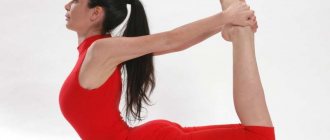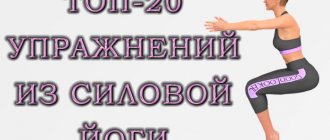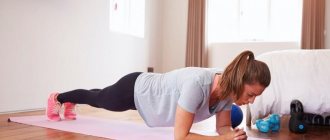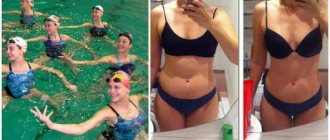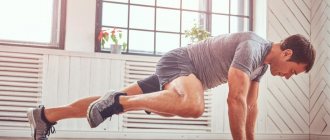To give your body an attractive shape, you need to choose the optimal set of exercises that will affect all the major muscles. A standard workout takes about an hour, it will help not only remove extra pounds, but also tighten sagging areas. By the end of the first month, with regular exercise, the result will become noticeable.
Warming up or warming up
Exercises for weight loss begin with warming up the muscles:
- you need to stand up straight and pull your hands up - if there is a feeling of warmth, then everything is done correctly;
- then run on the spot for several minutes;
- followed by warming up the core muscles: from a straight position, with hands on the waist, bend forward and to the sides.
The total time for warming up does not exceed 5-10 minutes. Warming up helps prevent accidental injuries while performing the complex.
Forget your excuses: morning exercises are here to stay!
People come up with many excuses for not doing even the simplest and shortest set of exercises for morning exercises. The most common self-justification options:
- “In the morning I don’t have the mood or strength to do gymnastics.” The morning exercise program is designed to ensure that your body becomes toned and filled with energy. Exercise helps speed up blood flow, wake you up, and lift your mood. What could be better?
- “I don’t have time for morning exercises.” Morning exercises, which will take no more than ten minutes, will be an excellent alternative to aimlessly lying in bed before getting up. So it’s not the time you lack, but the will!
- “Physical activity in the morning is harmful.” Another common excuse for lazy people. Of course, there is some truth in it, because if you jump out of bed onto a treadmill and run a sprint, it will not lead to any good, but will lead to a heart attack. However, a set of exercises for morning exercises is a light physical activity that will not harm you under any circumstances. If you know you have difficulty adapting to activity, prepare yourself. To avoid excessive stress on the cardiovascular system, you can perform a couple of warm-up exercises before the main complex. If this simple condition is met, morning exercises will only bring you good.
Abdominal exercises
The problem area requires increased attention. The complex should not contain only training to tighten a given muscle group; an integrated approach to all problem areas is necessary. Otherwise, a distortion of the waist silhouette will occur due to the strengthening of one press.
Recommended exercises are presented:
- “Twisting” - you need to lie on the mat, bend your knees, and put your hands behind your head. During entry, the head is pulled towards the lower limbs, and upon exit, the body returns to its original position.
- “Reverse twisting” - in a similar position, the legs are pulled towards the slightly raised head.
- “Raising the body” - in a lying position, the hands are behind the head. While inhaling, you need to raise your body and touch your feet with your fingers.
- “Lifting the legs” - in a lying position, the arms are spread up and to the sides. While inhaling, you need to raise your legs and try to touch their toes to the floor behind your head.
If the latter options are difficult to perform, then feasible workouts are initially selected.
Reducing leg volume
To improve skin tone and remove extra centimeters from your legs, perform the following leg exercises:
- forward lunges - engages the front of the thighs and buttocks;
- spreading the limbs to the sides from the healing position - pumping up the inner thighs;
- alternate lifting up – the condition of the anterior thigh improves;
- “bicycle” and “scissors” - the muscles of the inner and outer thighs are activated.
From a standing position, longitudinal and transverse swings of the legs are performed. To reduce the size of the femoral area, use:
- “triangular” yoga pose;
- squats - feet shoulder-width apart, toes apart;
- swinging the limbs with a small amplitude when lying on the side;
- moving the limbs backward from a position on all fours.
Strengthening the gluteal muscles requires:
- sitting on the edge of a table and holding a small object between your knees;
- in a lying position, alternately pulling your knees to your chest.
You can kneel down and alternately sit on one and the other side of your legs.
Arm and chest lift
When you lose weight, the first to lose pounds are your upper limbs and chest. To increase the elasticity of the skin and muscles, training with dumbbells is used:
- You need to lie down on a bench or 2 chairs arranged together. Then take dumbbells and spread your arms to the sides, bending and connecting them in front of your chest. The complex is repeated 50 times, helps to train the pectoral muscles.
- In a standing position, various actions are performed with dumbbells. It is allowed to raise the arms up and down, spread them to the sides and return to the reverse position at chest level.
Exercises for the shoulder girdle area include the following:
- You need to kneel and lean on your straight arms. The bend towards the floor takes place with the limbs bent at the elbows, then a return to the first position. A total of 25 approaches are used.
- Push-ups are performed from a table or the back of a sofa with straight legs and back. 15 repetitions are performed.
- In a standing position, your arms are spread to the sides and held parallel to the floor. Synchronized circular movements are made with a small radius, up to 30 times in a row. Later you can do a similar exercise, increasing the range of arm movements.
- You need to stand up straight, put your palms on your shoulders. Circular movements are made alternately in each direction, 20 times.
Training at the same time strengthens the pectoral muscles, allowing the bust to become toned and firm. After getting used to the specified workouts, they can be complicated with dumbbells. It is important to monitor your breathing during exercise.
Advice for a beginner athlete
29.Aug.2018
Health is a great blessing in a person’s life. We often forget about this while we are young and illnesses do not bother us. We neglect a rational regime of work and rest, physical training and hardening. Meanwhile, every person wants to be healthy and strong, to preserve beauty and youth longer. To achieve general health improvement, it is reasonable to use the simplest, most accessible and most effective method of physical activity, which, thanks to an increase in physical activity, ensures an increase in the level of human health, increases energy and has a positive effect on almost all systems of the body.
What does joining physical culture give each of us?
Physical culture makes it possible to maintain physical health, make your body beautiful, be able to control it and, most importantly, increase the body’s resistance to many unfavorable factors: lack of oxygen, hypothermia, penetrating radiation, infection, and the effects of toxic substances.
Physical exercise is an indispensable means of relaxing and neutralizing negative emotions accumulated during the working day. As a result, stress is relieved, sleep and well-being improve.
People who are actively involved in physical education have a higher level of performance and are less susceptible to various diseases. Due to the body's increased resistance to disease, athletes lose 3-4 times less working time per year due to illness than people who do not play sports.
Experts in the field of studying aging and the fight for longevity say: regular physical training adds not only years to life, but also life to years. Anyone who makes physical exercise, active rest and hardening part of their life can be convinced that this is really the case.
Where to start exercising?
In order for physical exercise to bring the greatest benefit, it is first advisable to get recommendations from a doctor, as well as evaluate your physical development. To determine the degree of physical fitness of practically healthy people under 50 years of age, you can perform the following simple test.
Climb to the 4th floor at a normal pace without stopping on the landings. If after getting up you breathe easily and do not feel any discomfort, then consider that you have a satisfactory degree of physical fitness.
If you feel short of breath when you reach the 4th floor, you are of average fitness. If severe shortness of breath and weakness occurred on the 3rd floor, you have poor physical fitness.
More accurate results of this test can be assessed by changes in heart rate before climbing the stairs and immediately after stopping. If you went up to the 4th floor and your pulse was below 100-120 beats/min. - This is good. If the pulse reaches 120-140 beats/min. – satisfactory. If the pulse exceeds 140 beats/min, the physical fitness of your cardiovascular and respiratory systems is poor.
Having received an idea of physical development and the doctor’s recommendations, you can begin to eliminate existing deficiencies and plan activities aimed at further physical improvement of the body.
What is the best time to exercise?
There is no clear answer to this question. You can exercise at any time of the day, but not earlier than 1-1.5 hours after eating. You should finish your classes at least 1.5-2 hours before bedtime.
How long should classes be?
The duration of the lesson depends on the degree of physical development and level of fitness of the body. For beginners it is 15-25 minutes, for physically fit and highly trained – 1.5-2 hours.
From the first days of introduction to physical education, it is necessary to remember that physical exercise is beneficial only when the load in the exercise strictly corresponds to the capabilities of your body.
How to do morning exercises correctly?
Morning exercises are a good means of transition from sleep to wakefulness, to the active work of the body. The duration of gymnastic exercises should be no more than 10-30 minutes, and the complex should include 9-16 exercises. The physical exercises used should be easy. These can be general developmental exercises for individual muscle groups, breathing exercises, exercises for the torso, relaxation exercises, for the abdominal muscles. You can compose a gymnastics complex yourself, borrow it from books, or perform it under the appropriate TV program. When doing morning exercises, do not try to “work up a sweat.” Exercise should invigorate and refresh. In no case should it cause fatigue, weakness, and especially other unpleasant sensations. Complete the exercise by showering or wiping down to the waist.
Do you need dumbbells, expanders and other equipment when charging?
Young and middle-aged practically healthy people, 5-6 weeks after the start of training, can perform some of the exercises with dumbbells weighing 1-1.5 kg or with an expander. But remember: when using different equipment, the number of repetitions of the exercise is reduced by 25-50%.
How to determine whether the load is selected correctly?
An objective indicator of the correct selection of exercises and compliance with physical activity is heart rate. Heart rate must be determined before and after performing a set of exercises. Immediately after exercise, it is considered normal to increase heart rate by 10-30 per minute, and return to the original state after 1-5 minutes. If heart rate does not recover during this time, then physical activity should be reduced by reducing the number of repetitions of each exercise, eliminating exercises such as squats and jumps from the set, replacing them with breathing ones.
To more or less fully satisfy the body's need for physical activity, one morning exercise, of course, is not enough.
During the day, if possible, it is necessary to perform a variety of physical activities. But physical activity associated with everyday household activity is mainly low-intensity, and less often medium-intensity. When performing them, energy consumption increases by 2-3 times compared to the resting state. And this is clearly not enough. Another disadvantage of household physical activity is the difficulty of dosing it and taking into account the body’s reaction to the work performed. Therefore, in addition to it, a person needs loads that are more intense and performed more evenly.
From this point of view, what loads are ideal?
The ideal loads are walking and running. Walking is the most ancient and elementary form of activity. It can be used not only as a way to move in space, but as an effective means of strengthening the body, in particular the cardiovascular system. They practice walking in the park and in the forest. This also gives classes a hardening effect, which is associated with being in the fresh air.
What are the walking paces?
There are several walking paces. Slow walking – up to 70 steps per minute. It is mainly recommended for patients recovering from a myocardial infarction or suffering from severe angina. For healthy people, this walking pace has almost no training effect.
Movement at a pace of 71-90 steps/min. refers to walking at an average speed (3-4 km/h). This speed is recommended for patients with cardiovascular diseases; its training effect for healthy people is low.
Walking at a pace of 91-110 steps/min. considered fast. The speed of movement with it is 4-5 km/hour. This type of walking is accessible to all healthy people and has a training effect on most of them.
Walking at a pace of 111-130 steps/min. is very fast. Not everyone, even healthy ones, can maintain this pace for more or less long time. This walking pace has a fairly powerful training effect.
Let's talk about running. Is this type of training recommended for all healthy people?
This type of training is more suitable for young and middle-aged people. Elderly people, if they are practically healthy, can also jog, but in order not to exceed the possible limit of the load, they need medical supervision. It’s another matter if an elderly person has been running since he was young. He is adapted to this type of training and has good practical experience. In this case, continuing to run is quite natural.
What type of running do you prefer for training?
Physiologists and doctors have found that a special type of running called jogging is most suitable for the prevention of cardiovascular diseases. Jogging is an easy warm-up run with complete relaxation, low hip lift, small “mincing” steps, with arms half-lowered. This type of running trains endurance well and is practically safe.
Basic principles when practicing recreational jogging:
- exercise, but do not overexert yourself;
- never race with others;
- always stick to “your”, most well-tolerated running pace;
- increase the load by lengthening the running distance, and not its pace;
- do not be shy and do not be afraid to take short breaks if necessary.
How long should the run be?
It all depends on the person’s training. Beginners can be recommended to run no more than 5-6 minutes in the first 2-3 months. If you feel well and the initial training has had a sufficient effect, the duration of the run can be increased to 10-12 minutes, but the same pace should be maintained. Many running enthusiasts strive to run as long as possible, even for several hours a day, covering tens of kilometers. This is completely unnecessary. A person who does not strive for athletic achievements has no need to be a marathon runner. 30 min. daily is enough for jogging. To easily cope with such a load, many beginners need to train, gradually increasing the load, for about a year.
What is self-control?
In order for physical exercise to bring maximum benefit, everyone who exercises independently must learn to control their health. Self-control is carried out using simple publicly available methods of self-observation and is based on subjective and objective indicators. Subjective indicators include: general well-being, performance, sleep, mood, heartbeat, shortness of breath, pain in the heart area. Objective indicators include heart rate, respiratory rate, body weight.
Self-monitoring data should be recorded in a special diary. The diary form is arbitrary. In the first column you can enter the names of the indicators. Subsequently – the dates of classes. It is advisable to carry out the determination of indicators at the same hours. Usually they start in the morning, on the day of classes, immediately after sleep, then repeat before the start of classes and at the end of them.
One of the main indicators of self-control is well-being. If physical education classes bring a feeling of vigor, increase performance, and improve sleep, then they are built correctly. A feeling of lethargy, weakness, irritability, persistent palpitations for hours, and especially the next day after exercise, indicate overwork and the wrong choice of physical activity. In this case, you should consult a doctor and reduce it. Only after the discomfort disappears can you increase the load again.
N. Tolstikova, Deputy Chief Physician for the Medical Department of
the Clinical Medical and Physical Education Dispensary


